Washington state discovers first ‘murder hornet’ nest in U.S.

- Share via
SPOKANE, Wash. — Scientists in Washington state have discovered the first nest of so-called murder hornets in the United States and plan to wipe it out Saturday to protect native honeybees, officials said.
Workers with the state Agriculture Department spent weeks searching, trapping and using dental floss to tie tracking devices to Asian giant hornets, which can deliver painful stings to people and spit venom, but are the biggest threat to honeybees that farmers depend on to pollinate crops.
“Ladies and gentlemen, we did it,” agency spokeswoman Karla Salp said at a virtual briefing. Bad weather delayed plans Friday to destroy the nest found in Blaine, a city north of Seattle.
The nest is about the size of a basketball and contains an estimated 100 to 200 hornets, according to scientists, who suspected it was in the area ever since the invasive insects began appearing late last year. Officials have said it’s not known how they arrived in North America.
Despite their nickname and the hype that has stirred fears in an already bleak year, the world’s largest hornets kill at most a few dozen people a year in Asian countries, and experts say it is probably far fewer. Meanwhile, hornets, wasps and bees typically found in the United States kill an average of 62 people a year, the Centers for Disease Control and Prevention has said.
The real threat from Asian giant hornets — which are 2 inches long — is their devastating attacks on honeybees, which are already under siege from problems like mites, diseases, pesticides and loss of food. A small group of the hornets can kill an entire honeybee hive in hours, and they have already destroyed six or seven hives in Washington state, officials said.
The nest was found after an Agriculture Department worker trapped two of the hornets Wednesday. Two more were captured Thursday, the agency said.
Using dental floss, “entomologists were able to attach radio trackers to three hornets, the second of which led them to the discovery of the nest” Thursday, agriculture officials said.
It was about 300 yards from the traps in the cavity of a tree on private property, officials said. Dozens of the hornets were seen buzzing in and out of the tree about 7 or 8 feet above the ground. The owner is letting the state eradicate the nest and remove the tree.
The plan Saturday is to fill the cavity with foam and cover it with plastic wrap to prevent the hornets from escaping, said Sven-Erik Spichiger, an entomologist for the Agriculture Department. Then a tube will be inserted to vacuum up the hornets trapped inside and deposit them in a collection chamber, he said.
Workers will wear thick protective suits that can prevent the quarter-inch stingers of the hornets from hurting workers, Spichiger said. They also will wear face shields because the trapped hornets can spit a painful venom into their eyes.
“We extract them alive,” he said. “We will kill them.”
The tree will then be cut down to extract newborn hornets and learn if any queens have left the hive already, he said. Officials suspect more nests may be in the area and will keep searching.
“It’s still a very small population, and we are actively hunting them,” Spichiger said.
Scientists for the department have been searching for nests since the first Asian giant hornets were caught earlier this year. The first confirmed detection of the hornet in the U.S. was in December 2019 near Blaine, and the first live hornet was trapped in July. Just over 20 have been caught so far, all in Whatcom County.
The invasive insect is normally found in China, Japan, Thailand, South Korea, Vietnam and other Asian countries. Washington state and the Canadian province of British Columbia are the only places the hornets have been found in North America.
More to Read
Sign up for Essential California
The most important California stories and recommendations in your inbox every morning.
You may occasionally receive promotional content from the Los Angeles Times.










